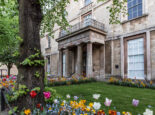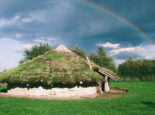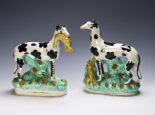Burghley’s Big Sleep
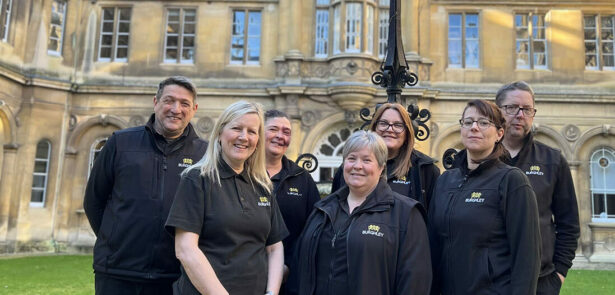
At the end of each October, Burghley House prepares to close its doors to the public and enter hibernation until opening again in early March. But just what goes on inside this magnificent, 16th century mansion during the dark, quiet days of winter? As it happens, quite a lot – and The Moment magazine was invited along for the day to find out...
I’m standing in the opulent surroundings of the Second George Room in the South Range of Burghley House – presented as it was when freshly decorated for a state visit from Queen Victoria and Prince Albert, all the way back in 1844. As you’d imagine for a room with such a history, it is eye-poppingly grand and exquisitely beautiful, not a thread, cushion or hanging tassel out of place; the four-poster bed is a gilded, red satin-draped galleon in full sail – the centrepiece of the room – and surrounding it is an array of the finest furniture, paintings and ornaments. And the tapestries – just, wow! We’ll come back to those later…
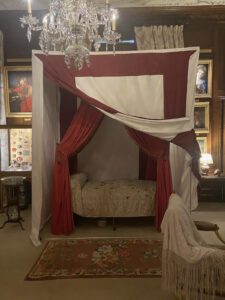
Princess Victoria’s bed with new winter covers
Apart from a silk rope looping across the room on a series of brass stands, there is very little here to suggest this might be in any way an exhibit – in fact the same goes for the whole of Burghley House. Despite its size, the ornate carvings and the barrel-vaulted staircases, there is a lived-in, welcoming and homely vibe about the entire place that turns what could be a series of dry, set-piece rooms into a true glimpse of living history. In fact, back in the Second George Room, it feels like Victoria and Albert have just popped out – perhaps for a brisk walk around Burghley’s stunning deer park – before returning to dress for dinner.
And in a way, this is what Burghley House’s big winter shutdown is all about. It gives the team here vital time to take care of the place as we all would our own homes, rather than treating it as a resource to simply be mined for an endless stream of footfall and engagement, clicks and Instagram opportunities. In an era when life is ‘content’ and experiences becomes a never-ending, disposable churn, the long, long game (since 1587) of repair, conservation, preservation, of age-old skills, feels both refreshing and reassuring.
But also… there’s scaffolding for the dusting.
Michelle Bloodworth is one of the housekeeping staff at Burghley House, and she’s offered to give me a behind-the-scenes tour of what goes into keeping Burghley House (and all of its belongings) in tip-top condition.
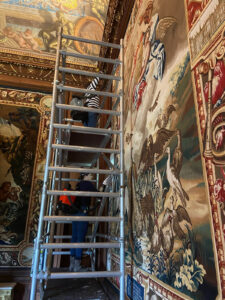
Cleaning Burghley’s tapestries. Photo by The Landi Company
“I generally like to go room by room and work my way back round. I start with high dusting, and I have to calculate whether or not I need scaffolding for the ledges that go round the top there.” She points out the ornate, decorative lip that runs around the entire room, about a foot from the ceiling. “Scaffolding?” I ask, slightly taken aback. “You have special interior scaffolding just for dusting?”
“Oh yes,” replies Michelle with a smile.
Of course – it makes perfect sense, really. In a place that has rooms on average 15 feet high, balancing on a chair isn’t really going to cut it.
Once up on the scaffolding, Michelle will use a combination of conservation-grade backpack hoover and a make-up brush to remove as much dust as possible not just from the ledge, but also all of the picture frames. It’s a mix of old and new tech, elbow grease and lateral thinking that enables this tricky, time-consuming and delicate job to be done with utmost efficiency, and without damaging bits of architecture and furniture that are hundreds of years old. I resist joking to Michelle that she can come and do my place when she’s finished – because it’s something I’m pretty sure she will have already heard.
I ask how long a room like this will take to dust and vacuum to her satisfaction, and the answer is: about five or six days. That’s an entire working week making sure that every item and surface is clean and well-maintained, an absolutely staggering act of labour when you consider Michelle has 18 rooms to do, each with equal care and attention to detail. I know how I feel when I have to drag a hoover round my own home, and listening to Michelle I feel a deep sense of awe at the patience, not to mention the physical discipline, that she must have in order to complete this job to the exacting standards she sets herself. The result is clear to see, and one to be proud of – every surface at Burghley House gleams, and it’s this rigorous cleanliness that also underpins the science of preservation, that is: ensuring old, precious things stay intact for as long as possible. Keep grime, dust, finger grease, acids and alkalines, not to mention beetles and bugs away from your stuff, and the chances of it prematurely decaying dramatically reduce.
And this is all after the soft furnishings have been dealt with (the state beds literally have tents constructed around them for the winter months, to keep dust and dirt at bay)…
Warp and weft
To look after pieces that are mostly or entirely fabric – that is, tapestries, wall hangings, embroidery and soft furnishing such as cushions, sofas and easy chairs – you need a whole other department. Luckily for Burghley there is one, tucked away in one of the courtyards! In 1963, Sheila Landi joined the V&A museum as a textile conservator and by 1972 she was heading up an entire section. In 1992 Sheila joined the team at Burghley, and in 2008 she set up her own business – the Landi Company Ltd – to restore and preserve not only the textile treasures in the House, but for a whole host of outside clients. The Landi Company is now part of the Burghley Conservation and Restoration group, a number of conservation businesses based at Burghley each with their own specialism.
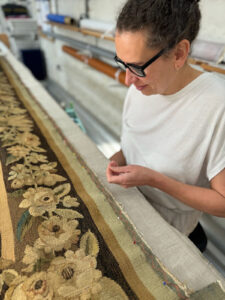
Melinda working on tapestry. Photo by The Landi Company
Whilst Sheila – at the grand old age of 94 – still takes a role in the company as their archivist, the company is now run by Melinda, Louise and Kelly: three formidably skilled and competent women known affectionately as ‘the Landi girls’ by the wider Burghley staff. I crossed from the main building into the network of outbuildings that have been repurposed to house various aspects of running the sprawling estate, to find out more about the magical crossover between art, craft and science that keeps every thread at Burghley looking so good.
At the Landi Company’s cosy HQ in a converted stable, I’m learning something curious: dirt is actually good. Or at least – dirt can be good. This is the philosophical conundrum that underpins the work of most if not all conservators, but particularly those who deal with the delicate and easily damaged.
“We do deal with private clients, and often they want things to look new – we have to, in a way, lower their expectations and explain that’s not what we do; we don’t restore things, we conserve them,” explains Louise. “And yes, we preserve the life of these things, but you also can’t just simply wash them – you’ve got to decide what can be taken away and what you need to leave behind, what has become in effect part of the item and its history, and what hasn’t. The classic example is Nelson’s coat. You’d never wash the blood out of it, even though technically it is a stain, because it’s a vital part of history. We also have to think about the object in the future – maybe the dirt will tell somebody something that can’t currently be analysed.”
And as with so much of history, it’s the little things – the ordinary things – that can tell us the most about the everyday life of our ancestors. Kelly adds: “If you really go into your fibre analysis on a textile, you can find out all kinds of things – what type of wool was used, what the breed of sheep was, where that sheep was most commonly farmed. We don’t have those facilities on-site, but if a client wanted to find out then the University of Lincoln has those resources, that we’re able to use.” (All the Landi team studied, at one point or another, at the University of Lincoln – it’s one of the go-to educational centres for conservation, and the company maintains strong links with the departments there.)
I ask if they’ve ever had to undo any badly-done repairs (my mind straying irresistibly to the infamous Elías García Martínez’s fresco of Christ’s face that was… amended, by a well-meaning but amateur restorer). The answer is ‘yes’ but – as with Nelson’s coat – there’s a lot more to it than that.
“We find that textiles often have been repaired by someone in the past who wasn’t trained, but if the item is a family heirloom there might be a sentimental attachment to that because it was done by a relative,” says Melinda. “It comes back to it being more of an ethical question, and in that case we’d only undo the repair if it were damaging to the object. If it wasn’t, then we’d be inclined to leave well alone.”
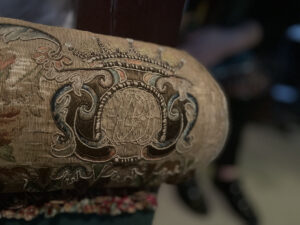
State bed detail
We’re back to the concept of that long game, of any act of conservation being just one step on a centuries-old path into the past – but also, the future. Melinda continues: “You know, from just 30 years ago things have developed in this field, some adhesives aren’t used anymore because of their being discontinued, or they’re found to be toxic – practices are always changing. So you look at a treatment that was done 50 years ago and it’s essentially become part of history. We’re aware that in 50 years time people might look at our work and say, ‘Oh, you shouldn’t have done that, we wouldn’t do it that way’. Kelly, Louise and I always follow the accepted conservation standard that our work is designed to fail and is reversible, so that in years to come someone could come along and save the piece in a new and different way.”
To find out more about Burghley House and the collections within, visit burghley.co.uk – the Deer Park and restaurants are open throughout winter (check dates and times) so there is always something to enjoy, even while the House is sleeping!
For more information on the Landi Company and the work they do, visit landico.co.uk
The Burghley House guide to saving a tapestry
Not all tapestries, of course, because every single one will require a different approach depending on what it’s made from, how it was made and when. But Melinda Hey, one of the Directors of Burghley’s on-site textile conservation resource, the Landi Company, is kind enough to give me a quick restoration and conservation master class using a piece she’s currently working on – a 17th century Aubusson tapestry from France made primarily from wool thread.
Firstly, the object is attached to a specially-built frame comprising three rollers, which will enable Melinda to keep the piece at the correct tension while she works, and to roll each section along once she’s finished with it. The frame is enormous at five meters, built to accommodate even the biggest tapestry.
“We’ll attach conservation-grade linen to the back of the piece by marking out straight lines across the front to act as a reference grid, helping us keep the tapestry and linen aligned as we work – sometimes the item will be horribly warped, which is a bit of a nightmare! The tapestry is then consolidated with conservation stitching, including ‘brick couching’, ‘laid couching’ and general support stitches.
“This particular piece is made mostly of wool, but a lot of the areas of loss, towards the middle, are silk, which is far more delicate than wool and more prone to damage. Silk was often used to make particular parts of the design look shiny or shimmery – like the sea or sky in pictorial designs. We replace silk with cotton, however, because it will keep its colour better and last longer. At the end of the process we’ll finish up by putting a lining on, which is important because it protects the reverse of the tapestry from the wall and from dust settling.”
Burghley’s textile treasures
As you explore the House, it’s worth looking out for some of the collection’s most prized pieces…
Bow Room
The curved sofa in the window features
a classic flame pattern worked in a needlepoint style called Bargello. The origins of Bargello, an embroidery style that references mathematical patterns, aren’t clear, but there are historic links to both Florence and Hungary and the technique dates from at least the 17th century.
The curtains are modern and were left in situ after a popular television series was filmed in this room earlier this year.
Brown Drawing Room
The bed coverlet has oriental-style embroidery worked in silk threads on a silk ground. Having been on open display for an extended period of time, the cover is heavily light damaged. Silk is especially vulnerable to light damage and treatment for light damaged silk is usually limited to applying an adhesive support and/or applying conservation net.
Black and Yellow Bedroom
The tapestries in this room are known as the Grotesque Tapestries ‘Fame’ and ‘Fortitude’ and were made by Jon Vanderbank in his Soho workshops (Covent Garden) circa 1680. At the time, Vanderbank was the most renowned tapestry maker in England, supplying the royal family with tapestries from his workshop until he died in 1717.
These tapestries are known as the Grotesques. They are in a ‘Berainesque’ style named after the work of Jean Berain the Elder (1640-1711) a designer and engraver associated with The Royal French Palaces. Grotesque tapestries can be identified by flower swags, garlands, trophies, exotic creatures and sometimes human heads and torsos.
(These two tapestries were conserved by the Landi Company in 2005.)
Great Hall
Above the fireplace hangs a Mortlake tapestry. This tapestry is one of a series known as The Naked Boys or Boys in the Trees, and it was conserved by The Landi Company in 2019.








